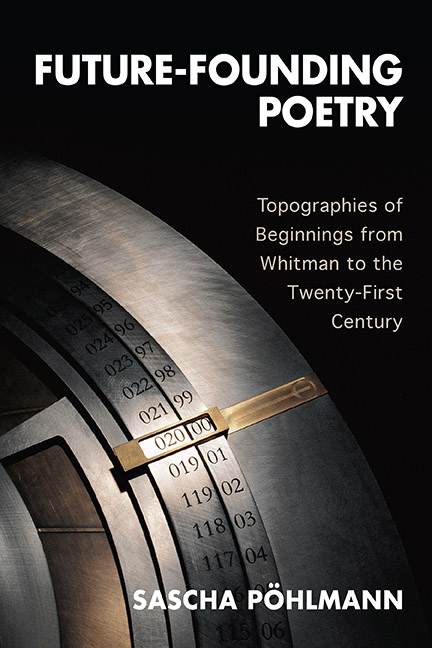Book contents
- Frontmatter
- Contents
- Acknowledgments
- Introduction: On How to Begin, and Where
- 1 Whitman: Beginning American Poetry
- 2 Williams: Beginning Again
- 3 Hughes: Urgent Beginnings
- 4 Rukeyser: Communal Beginnings
- 5 Ginsberg: Defiant Beginnings
- 6 Future-Founding Poetry after 9/11
- Conclusion: On Where to End
- Notes
- Works Cited
- Index
6 - Future-Founding Poetry after 9/11
Published online by Cambridge University Press: 25 May 2021
- Frontmatter
- Contents
- Acknowledgments
- Introduction: On How to Begin, and Where
- 1 Whitman: Beginning American Poetry
- 2 Williams: Beginning Again
- 3 Hughes: Urgent Beginnings
- 4 Rukeyser: Communal Beginnings
- 5 Ginsberg: Defiant Beginnings
- 6 Future-Founding Poetry after 9/11
- Conclusion: On Where to End
- Notes
- Works Cited
- Index
Summary
No one wants to look at my disaster
It has become a construction site
—Vicki Hudspith, “Nodding Cranes”WHEN SHELLEY JACKSON PUBLISHED an essay on Jenny Holzer's animated- text installation in the rebuilt tower of 7 World Trade Center—a reminder that more than two towers were destroyed on September 11, 2001—she framed it with a line from E. B. White's book Here Is New York: “The city is like poetry.” As she explores this simile, she considers the city as text, as a place of complexity, order, and fluidity:
Climbing out of the New York subway onto a lower Manhattan street corner is like opening a book in the middle. There is a strict architecture in which right angles predominate. Traffic is guided into lines. There are passing citations (GAP, CHASE) and block quotes. But everywhere there are endings and beginnings: a cemetery, dotted with full stops; a construction site. Often the two are one and the same: where one building falls, another rises.
This last idea is especially pertinent to the relation between this particular city and the poetry that has been written in the aftermath of the event that has most profoundly affected it in the twenty-first century, and this is the issue I will address in this final chapter: How does poetry on 9/11 make and mark beginnings? How does it deal with this problematic confluence of endings and beginnings, how does it—quite like Ginsberg's poetry—imagine a future where the present seems to only think of endings? How does it work in accordance with Alain Badiou's dictum that “it is essential to break with the omnipresent motif of finitude” (122), with which he opposes a philosophical as well as cultural and political tendency toward nihilism that, according to Badiou, manifested itself in discourses on 9/11 and especially on the “war on terrorism”? In the following analysis, I will show that poetry responds to 9/11 by strongly drawing on a future-founding mode, and that a Whitmanian future-founding poetics has become especially prevalent and significant after 9/11 to the point of actually invoking Whitman as a person as well as an intertextual reference.
- Type
- Chapter
- Information
- Future-Founding PoetryTopographies of Beginnings from Whitman to the Twenty-First Century, pp. 304 - 352Publisher: Boydell & BrewerPrint publication year: 2015

